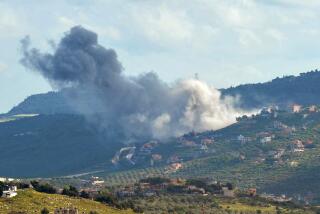1,000 Attack U.S. Embassy in Honduras
- Share via
TEGUCIGALPA, Honduras — More than 1,000 students marched on the U.S. Embassy on Thursday and burned 20 automobiles to protest the expulsion to the United States of a reputed drug kingpin before being turned back by gunfire and tear gas.
Police said at least one demonstrator was killed but local radio stations put the number of casualties at four dead and two wounded.
The privately owned Honduran Radio Nacional and Radio America said at least four people had died from gunshots fired from inside the embassy annex.
Tried to Set Fire
The crowd, which tried to set fire to the embassy, also was protesting the deployment of American troops in Honduras last month in response to a border incursion by Nicaraguan forces.
Guards stationed at the embassy lobbed tear-gas grenades and fired at demonstrators who set fire to about 20 cars belonging to embassy personnel.
Police sources identified a woman who was killed as Betty Molina, but gave no further details.
The Honduran radio stations identified the four dead as Henry Napoleon Garcia, Fredy Alberto Pineda, Rolando Erazo and Aguero Cruz. They were identified as university and high school students.
Other reports indicated that the third floor of the U.S. Consulate was burning fiercely and that part of the outside of the main U.S. Embassy building across the street was also ablaze as firefighters arrived.
On Tuesday, Honduran officials took Juan Ramon Matta Ballesteros from his Tegucigalpa home in a pre-dawn raid and hustled him onto a plane to the Dominican Republic without a passport.
Dominican Republic officials put Matta on a New York-bound flight, and he was arrested aboard the jetliner by U.S. marshals.
Matta, now lodged at the maximum-security federal prison in Marion, Ill., was also wanted by U.S. officials for questioning in the 1985 torture-murder of U.S. drug agent Enrique S. Camarena in Mexico.
Protest Against Troops
The protesters also reportedly were demonstrating against the presence of U.S. troops in Honduras last month. President Reagan dispatched the troops at the request of President Jose Azcona Hoyo after the incursion into Honduras by Nicaraguan troops pursuing U.S.-backed Contras.
Earlier Thursday night, in a telephone interview from his home two miles from the embassy, U.S. spokesman Michael O’Brien said: “This thing is still going on . . . I can still see smoke coming from there.”
Radio reporters said it was the largest and most violent anti-U.S. demonstration ever in Honduras, traditionally Washington’s closest ally in Central America.
The demonstrators, chanting “Matta yes, gringos no!” marched on the embassy after protesting outside the nearby presidential palace, which was guarded by around 50 armed troops.
Bars Extradition
The constitution bars extradition of Honduran citizens, and Matta’s seizure has stirred widespread resentment here with both the Honduran and U.S. governments’ treatment of Matta.
Azcona had said last month that Matta could not be legally extradited because he was protected by the constitution. Officials involved in the expulsion have refused comment.
The protesters called for Matta’s repatriation, chanting “Azcona, if Matta doesn’t come back, we want your head!”
Earlier, a local radio station said the United States had put pressure on the government to oust Matta by threatening to publish evidence linking military officers to drug trafficking.
More to Read
Sign up for Essential California
The most important California stories and recommendations in your inbox every morning.
You may occasionally receive promotional content from the Los Angeles Times.













